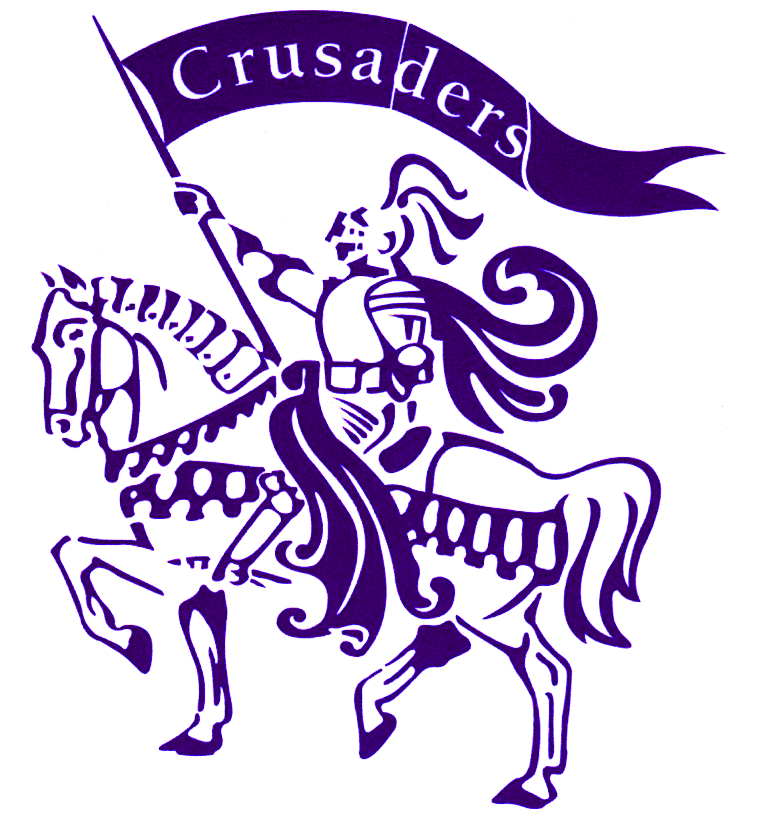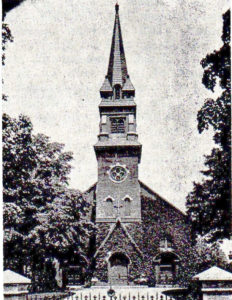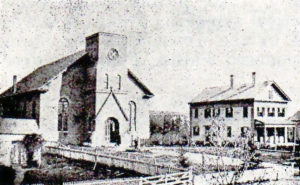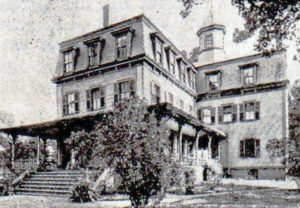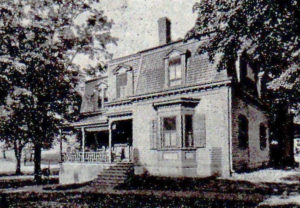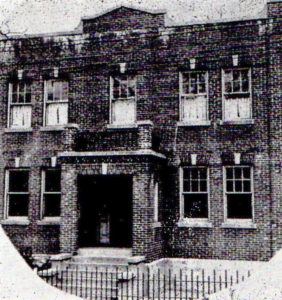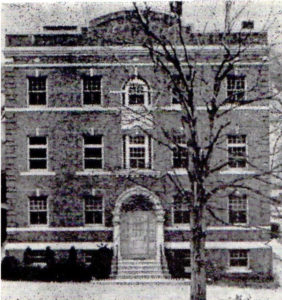Waltham, MA (September 1891 to June 1973)
Waltham is one of the oldest seats of Catholicity in Middlesex County, though just when Catholics first arrived here is unknown. In the year 1830, the few residing in this town and in Watertown, Newton, Lexington, Concord and other places in the vicinity, amounting to 300 in all, were assembled when occasion would permit by some priest residing in Boston The country which the early missionary in New England was compelled to cover extended as far north as Maine and as far south as New York; consequently, he was unable to give much time to any one mission. Waltham seems to have received a generous share of attention, for it was formed into a parish in 1835, and a small wooden church was erected on the land then known as the old Catholic cemetery on Church Street.
The first resident pastor was the Reverend Michael Lynch, appointed in 1840, when the congregation was nearing 400. He remained in Waltham only two years, when, on his appointment to another field of labor, the Reverend John Strain was sent to succeed him. This Second pastor, after an equally short term of office, was transferred to Fitchburg; and St. Mary’s welcomed its third pastor, the Reverend Patrick Flood. A memorable event of his administration was the destruction of the church by fire, June 4, 1846, a misfortune which called out beautiful expressions of practical sympathy from the towns– people. The selectmen offered the use of the Town Hall for divine service, while the Unitarian Society tendered Father Flood the freedom of their church.
For the following twelve years, Watertown was the center of the parish, since the number of Catholic families had most notably increased in that direction; however, the high tide of immigration in the early fifties reached Waltham in due time, so that in 1858 Father Flood began preparations for the erection of the present church edifice on School Street. Though a portion of it was in use, the building was still unfinished when death called the zealous pastor on December 5, 1863. His successor was his young brother, Reverend Bernard Flood, whose appointment marked the separation of the two towns, and Waltham again became an independent parish. Father Flood pushed the building of the church on to completion, bought land for Calvary Cemetery, the part now called “the old cemetery”, and in 1875 undertook to enlarge and beautify the church, so greatly had the congregation increased. He was not destined to see his work finished, however, for he died suddenly five days before Christmas, 1876.
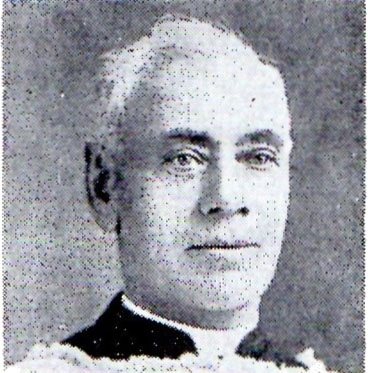
Reverend Brosnahan.
Two weeks later, on January 4, 1877, the on Reverend Timothy Brosnahan assumed the charge of Pastor of St. Mary’s. With the church only nearing completion, $40,000 had been expended on the work, and by the time all was finished, a debt of $24,500 remained. To an energetic young pastor and a devoted people, this was no great burden, and in two years the parish was clear of debt and ready for new and necessary additions. Indeed, that very year, 1879, they celebrated their advance by purchasing seventeen acres of land to increase the area of Calvary Cemetery, and soon afterwards, a $1,500 church bell.
As the work increased and additional assistants were assigned — for St. Mary’s parish now included the whole of Waltham and its suburbs — the need for a larger rectory was keenly felt; accordingly, a new rectory, of brick to correspond with the church, was begun in April 1882 and was completed and occupied June 23, 1883. The former rectory (then to become the first convent) was moved to the site where the present convent now stands, and the dwelling occupied by Mr. W. F. Rooney on School Street was moved to Pond Street; the land thus cleared around the church was graded and laid out in beautiful lawns, with broad cement walks, and the whole church property enclosed by a granite and iron fence. The five hundred loads of loam needed for this grading were taken from Calvary Cemetery, which was also graded and improved at the same time. The cost of all this work was nearly $37,000., of which almost $25,000 had been expended on the new rectory. In 1902, the church was renovated at a cost of $50,000, making it one of the most beautiful in the Archdiocese.
The Fathers of the Third Plenary Council of Baltimore in 1884 laid great stress upon the necessity of providing in every parish schools wherein the children of both sexes should be taught, with the elements of all secular sciences deemed fitting, the essential truths of religion and their bearing upon daily duties of life. Father Brosnahan had long desired such an education for the children of his parish — lack of means alone had delayed him; and now, though he had but a paltry $5,000 available, this new impetus to his zeal made him cast himself once more upon the generosity of his faithful people. They responded so promptly and nobly to his appeal that ground was broken for St. Joseph’s Parochial School on October 29, 1886, and the foundations were laid before frost interrupted the work. The following April, work on the superstructure was resumed and completed in July 1888.
The original $5,000 had undergone a vast expansion by this time; the sum had grown in fact to $90,000., including not only the expenditure for the imposing new school building, but also the heating apparatus, desks and supplies, grading and the like. As all then stood, the debt was $35,000., a very creditable showing for the people of St. Mary’s.
About the first of July, 1888, Father Brosnahan went to the Convent of Notre Dame, Berkeley Street, Boston, in order to obtain Sisters for the girls department of his new school, which was to open in September. At his request, Sister Mary Bernadine visited Waltham and was so charmed with the place and the number of youngsters awaiting religious education that she wrote a glowing account to her Provincial, and the new field of labor was accepted immediately. The former rectory was remodeled to outfit it as a convent for the Sisters and was ready in less than a month, so that on the last day of August, the community, numbering seven Sisters, took possession of their new home.
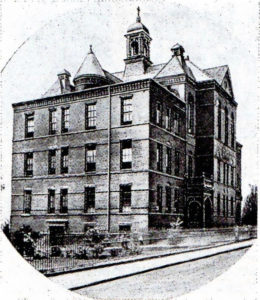
St. Joseph’s School, 1888.
The ceremony of dedication of St. Joseph’s School was performed on Sunday afternoon, September 2, 1888 by the Most Reverend John J. Williams, Archbishop of Boston. When school opened on Tuesday, September 4, the number of children who presented themselves — 850, both boys and girls — was far greater than had been expected. Consequently, the ten rooms prepared for them proved inadequate for their needs, and for several months a large proportion of the children had to remain ungraded. (In accordance with the established system in Catholic educational institutions, the boys and girls departments were kept entirely separate.) The teaching force which faced the arduous task of putting the classes in order consisted of seven Sisters. Sister Mary Seraphine was the Superior, and assisting her in this class organization were Sister Mary Marcellina and Sister Mary Loretto, who were in charge of the upper grades. The boys department was in charge of a corps of lay teachers under the direction of Mr. Owen Doherty. Among the teachers were two Waltham girls, Miss Sarah Handrahan and Miss Mary F. Leonard, both Normal School graduates.
For the next few years, the Pastor was endeavoring to secure religious teachers for the boys department. Finally, in 1891, he succeeded in making arrangements with Brother Clementian, Superior of the Brothers of Christian Schools, to establish a community in Waltham. The Moore Estate was purchased and readied as a home for the Brothers, and on the Feast of the Assumption of the Most Blessed Virgin, August 15, 1891, six Brothers arrived in Waltham: Brother Noah, the Director, a nationally famous educator and author; and Brothers Baldwin Peter, Conald Joseph, Barsabas Lewis, Linus of Mary and Arnulf Paul. When classes opened on September 8, the four upper classes of boys were in charge of Brothers. A Miss Watson was in charge of the Fifth Grade; Miss Leonard, the Fourth; and the three lower grades were in charge of the Sisters.
Coincidental with the advent of the Brothers was the opening of the high school, St. Joseph’s High for the girls, and LaSalle High for the boys, named in honor of the Sainted founder of the Christian Brothers. The first teacher of the boys “High Class” was Brother Baldwin, who purchased about ten typewriters, and without fanfare, the school’s commercial department was inaugurated.
Because of the increase in the number of pupils, it was necessary to use the church basement and the gym in the school basement for classrooms. In 1892, the Boys High School had to be discontinued for a few months pending the arrangements of better accommodations. At Christmas time, it was moved into the end of a large hall on the top floor of the school, and eventually into a tenement house on Lexington Street. The school continued to expand; as an example, at the opening of the 1912 school year, there were nearly 700 girls and 580 boys. The teaching corps consisted of 22 Sisters, 7 Brothers and Miss Leonard; twenty-one classrooms in the school were in use, as well as these other facilities. On September 7 to 10, 1913, Father Brosnahan led his parishioners in the celebration of the Silver Jubilee of St. Joseph’s Parochial School.
It was Reverend James Baxter, Sixth Pastor of St. Mary’s Church (1919–1935), who built the new high school and changed its name from “St. Joseph’s”-“LaSalle” to “St. Mary’s.” A fund drive was launched on May 16, 1920, ground was broken for the new school on March 24, 1922, and the building was completed in 1923. Both the Boys and Girls High School Departments were moved into the new building, occupying separate wings, with separate staffs of Brothers and Sisters. During his Pastorship, Father Baxter also built a new Convent in 1923, a new residence for the Brothers in 1925, and an addition to St. Mary’s High in 1931–32. Perhaps his greatest contribution was his introduction of the classics into the high school curriculum in 1923, a boon to the cause of vocations.
During the Pastorship of Right Reverend John E. O’Connell, seventh Pastor of St. Mary’s (1936-1954), all buildings of the parish were renovated over a 4-year period from 1936 to 1940. The Golden Jubilee of the school was observed October 5 to 8, 1941, culminating in a testimonial banquet at the Hotel Statler in Boston which was attended by more than 500 distinguished faculty, students, alumni and friends of St. Mary’s High.
The Right Reverend Thomas A. Flynn, St. Mary’s eighth Pastor (1954-1968), continued to give to the Brothers and Sisters his trust and confidence that they could run good schools. It was during his Pastorship that lay teachers were added to the school staffs, and Catholic schools everywhere were beginning their struggle for survival.
From its first years, the school has always held a high rank in its standards of scholarship and in public competition. At the time of the Columbia Exposition at Chicago, 1893, specimens of class work were sent to the educational exhibit. They were judged so excellent that the Committee of the Department of Education awarded a gold medal and two diplomas to the school, with five additional diplomas for individual pupils.
During the administration of Brother James (1902-1906), the school entered the Boston Archdiocesan Competitive Examinations; the first year, it won three gold medals and nine honorable mentions. Under Brother Hyacinth, St. Mary’s boys were frequent winners in the annual contests in Christian doctrine inaugurated by Father Walsh, afterwards Bishop of Portland. During the administration of Brother Anselm Emilus (1913–1917), the school won first place in a national Palmer Method contest.
Shorthand and typewriting were among the specialties of the School for more than half a century, and it was Brother Gregory who established the commercial department on a firm foundation. At the turn of the century, students had no difficulty in passing the exams in Boston Bureaus and securing positions. The regime of Brother Basilian as Principal (1919–1924) presents an endless list of awards and championships in shorthand and typewriting contests conducted by the Underwood Company. St. Mary’s boys won the New England type writing championship for four consecutive years; one boy won the national championship; and another, the world’s championship. The various trophies still adorn the typewriting room to serve as an inspiration to those of the present generation. The Girls Department has always had a strong secretarial curriculum, and they, too, won their share of medals and awards, including scholarships to Bryant and Stratton and various academies.
From 1939 to 1941, the school won several prizes for public speaking and debating. In 1958-59, St. Mary’s was the pilot school for M.I.T.’s Physical Science and Study Committee project.
Reverend Joseph B. Corkery, who had served as a curate at St. Mary’s Church from 1942 to 1953, returned as its Ninth Pastor in October 1968. By this time, the parish was feeling the pressures and mood of the times — the closing of many Catholic schools. There had been a decrease in enrollment in both the parochial and high schools for several years (enrollment in the first grade was down to about 20–25). A decline in religious vocations necessitated the addition of lay teachers to the staff of both schools and tuition income did not cover the costs of operation; consequently, the parish was subsidizing a substantial portion of the operating expenses for both schools, amounting to about $50,000. Moreover, since most of the high school students were now from outside of the parish, it was difficult to justify such an expenditure as a parish responsibility.
In the fall of 1969, Father Corkery sadly announced that the high school would be phased out, but heeding the pleas of parents that students currently enrolled be allowed to graduate from St. Mary’s, the phase-out would extend over a four-year period. The Girls Department closed the following spring with the 1970 graduating class. 18 remaining junior girls pleaded so desperately to be allowed to finish their high school education at St. Mary’s, that in 1970–71 the school went coed for the first and only year in its history, and the girls graduated with the boys in June 1971.
Meantime, St. Joseph’s Grammar school was cut back to six grades, which moved into the high school building in September 1971. The grammar school building stood idle and unused for a year, and was razed in the summer of 1972. The grammar school operation, too, will close with the high school.
Approximately 2400 boys and 2600 girls have graduated from St. Joseph’s-LaSalle-St. Mary’s High School during these past 82 years. A school is usually judged according to the measure of success achieved by its graduates, and in this respect, St. Mary’s yields to no one. It can boast of a host of graduates who have been successful in every profession, trade and endeavor. One class alone — the Class of 1909 — has produced three college Presidents, Brothers Cornelius, Victor and Joseph. St. Mary’s graduates credit what they are and what they have done to the dedicated efforts and teachings of their Pastors, the Sisters of Notre Dame De Namur and the Brothers of Christian Schools.
On Sunday, June 3, 1973, the doors of St. Mary’s High School will close — the end of 82 years of outstanding Catholic high school education in Waltham.
